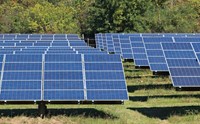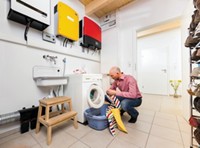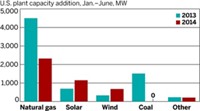Advertisement
Grab your lab coat. Let's get started
Welcome!
Welcome!
Create an account below to get 6 C&EN articles per month, receive newsletters and more - all free.
It seems this is your first time logging in online. Please enter the following information to continue.
As an ACS member you automatically get access to this site. All we need is few more details to create your reading experience.
Not you? Sign in with a different account.
Not you? Sign in with a different account.
ERROR 1
ERROR 1
ERROR 2
ERROR 2
ERROR 2
ERROR 2
ERROR 2
Password and Confirm password must match.
If you have an ACS member number, please enter it here so we can link this account to your membership. (optional)
ERROR 2
ACS values your privacy. By submitting your information, you are gaining access to C&EN and subscribing to our weekly newsletter. We use the information you provide to make your reading experience better, and we will never sell your data to third party members.
Environment
Firing Up The $1 Trillion Network
Growing demand for renewable energy and electricity spurs push for smart electricity grid
by Jeffrey W. Johnson
January 3, 2011
| A version of this story appeared in
Volume 89, Issue 1

It’s a fact that the wind doesn’t always blow and the sun doesn’t always shine. It’s also a fact that few people in the U.S. live in those rare places where it is mostly windy or hot. Although obvious, these simple truths create problems for those trying to increase the amount of electricity generated by renewable-energy sources such as wind and solar.
But U.S. dependence on renewable energy is growing—both to meet energy needs and to curb climate change by cutting greenhouse gas emissions through reducing fossil-fuel use. Some 30 states and the District of Columbia have enacted incentives for more renewable energy. California has the most demanding requirement, calling for 33% of its electricity to come from renewable sources by 2020. Other states have set less rigorous goals, but several seek 20% or more from renewables in a dozen or so years.
These levels are a huge jump from the current meager contribution of renewables—2% from wind and less than 1% from solar—and adding more solar- and wind-generated electricity to the U.S.’s 100-year-old electric grid will be expensive and technologically difficult. It also is unlikely to happen without a major overhaul of the nation’s electricity distribution system, according to utility executives, scientists, and energy engineers.
Consider the impact that a shift to wind power would bring to today’s energy world that is dominated by large coal-fired power plants whose output is controlled by the flick of a switch, day or night. With wind, the fastest-growing renewable source, a utility operator must react to the output of thousands of small turbines in large wind farms, usually operating in remote locations. Each turbine is powered by Mother Nature—a fuel source outside the control of any grid operator. Most wind blows at night, and turbine output can vary from zero to full in a heartbeat.
How to orchestrate a constant stream of electrons through the distribution system by combining such fickle sources is a tall order for any grid operator using today’s slow and sometimes manual controls.
Enter the “smart grid”—a catchall name for a number of technological fixes to the current electricity grid. The smart grid would merge new technologies with changing energy needs and drive the U.S.’s electricity generation, transmission, and distribution system into the 21st century, says Don Von Dollen, IntelliGrid program manager for the industry-funded Electric Power Research Institute (EPRI).
The smart grid would depend on a host of new technologies, but one is particularly illustrative of the goal of grid stability. The synchrophasor is a computer-sized device installed in a transmission-line substation. It can monitor the grid by measuring the physical conditions of voltage and current flowing through the system several times per second. Operators could use it to measure and compare flow at different grid locations. The smart grid would employ thousands of these devices, measuring changes in generation and load and balancing the system through instant responses.
The smart-grid revolution is just getting under way in varying degrees at U.S. utilities. Also, the Department of Energy has provided R&D support, most recently allocating $4.5 billion in American Recovery & Reinvestment Act of 2009 funds for smart-grid R&D and deployment of smart-grid sensors, monitors, and other equipment, including millions of smart meters at the customers’ end of the line.

“The smart grid is the result of the intersection of several simultaneous events,” Von Dollen says. “One is the communication and information technology revolution that has completely transformed other industries with sensors, monitors, and wireless communication systems. The other is the need of the electricity industry to start moving away from fossil fuels to be mindful of carbon dioxide emissions and to encourage more efficient use of electricity,” he explains. “The smart grid means we will be able to count more on renewable energy and distributed energy sources for the future,” he adds.
Although Von Dollen defends the current grid, citing its “evolution” and its “elegant and beautiful solutions” that have powered the U.S., he says: “We have to make the old dog learn new tricks.”
“With today’s old central power plants,” Von Dollen says, “life is simple. You turn them on and get this steady stream of electrons. You don’t have to worry about it. With renewables, you can get some dramatic drops in output minute to minute, day to day.” This inconsistency, he explains, means that “you have to keep the fossil-fuel plants on standby, off-line but still idling and still producing emissions. You haven’t gained much.”
A study by Bentek Energy, a Colorado energy consulting firm, found that reductions in carbon dioxide emissions through wind energy would be lost if coal-fired power plants were started up to offset even brief wind variability. The company is now nearing completion of a broader study examining the same impacts, says Brannin McBee, an energy analyst with Bentek.
And a report by the American Physical Society (APS) states that in the not-too-distant future, electricity produced by remote renewables won’t be usable because of inadequacies in the existing grid, particularly the grid’s inability to adjust to natural variability and the lack of transmission lines between remote solar and wind sources and urban centers, notes Kathryn Clay, one of the report’s authors and vice president for R&D policy at the Alliance of Automobile Manufacturers. The report singles out sources of solar energy in the Southwest and of wind energy in the West, Midwest, and potentially offshore that are far from population centers.
Electricity generation, Clay notes, must match demand. It is the ultimate “just in time” system. APS wants more renewable-energy sources on the grid and supports the addition of stationary storage and batteries to back up them up. She adds that R&D from the Department of Energy has focused too much on technically complex vehicle batteries and not enough on grid-based stationary storage.
The grid, she notes, faces a growing number of demand challenges, such as the arrival of electric vehicles. Such vehicles will need to be plugged into the grid to be recharged, and exactly when consumers choose to do so will impact electricity demand.
Balancing the grid’s electricity generation with cheap, powerful stationary storage batteries would solve the variability problem for renewables; unfortunately those batteries don’t yet exist. Smart-grid advocates, however, have a more revolutionary plan: Along with synchrophasors and other new grid hardware, they want the electricity consumer and the power system to “talk” to each other and adjust electricity demand to match supply, rather than the traditional method of the power system upping supply to match consumer demand. And they want this communication to be second by second, automatic, and painless.
Indeed, constant two-way communication between electricity generators and electricity users is at the heart of the hope for a smart grid.
“If you think of the smart grid as a laptop computer, the existing grid is an abacus,” says CD Hobbs, a former utility executive and a senior fellow at the Public Utility Research Center of the University of Florida. He notes a pressing need to technologically upgrade the existing grid and its components that are already exceeding their 40-year expected lifetimes, but he also underscores the need to rethink and revamp the whole regulatory and business system that supports the grid to allow new information technology entrepreneurs into the old-fashioned, utility-dominated system.
Much has changed since Thomas Edison designed and built the world’s first central power station in New York City in 1882 and ran the initial transmission lines from his Pearl Street power station to Wall Street. Edison’s success led to the formation of utility companies and the creation of “power pools” to provide electricity to more and more customers during the first half of the 20th century. Eventually, individual utility companies connected local transmission systems into small energy networks that jointly owned the power plants and transmission lines.
The system evolved into three major regional power grids: the Eastern Interconnect, the Western Interconnect, and the Texas Interconnect. Together, they form a loosely joined national grid within which more than 3,000 utilities now operate about 10,000 power plants. Several hundred private and public entities own the transmission grid, and approximately 130 authorities balance electricity generation and load and dispatch power and serve customers across the U.S. And they do this with a centralized, intertwined infrastructure, most of which was designed more than 50 years ago. The system is controlled by a complex bureaucratic maze of regulatory bodies.

According to APS and EPRI, funding for the grid has been historically low despite growing electricity demand. From 1988 to 1998, electricity demand grew by 30% while transmission investments increased by only 15%; from 1999 to 2009, demand grew by 20% while transmission investment increased by only 3%.
Creating a smart grid would be an enormous undertaking. A study by Brattle Group, an international economic consulting firm, estimates that grid and generation infrastructure improvements could cost more than $1.5 trillion by 2030. Some $900 billion would pay for modernized transmission and distribution. New electricity generation facilities would run nearly $700 billion. However, the report notes, generation costs could be cut by improvements in energy efficiency and use of advanced “demand-response communications systems” between the customer and generator, which would include new smart meters for consumers.
With a digitized system, new software, and enhanced communication between the utility and consumer, consumers may be able to reduce the amount of electricity they use during peak, high-demand times, and utilities may find that they have a surplus of electricity and therefore additional generation capacity is not needed, Hobbs says.
“The question is,” Hobbs says, “how will we reach this Nirvana?”
Steven G. Hauser, the National Renewable Energy Laboratory’s vice president for grid integration, sees a three-step, 10-year-plus path to the smart grid. Step one is the introduction of advanced relays, efficient transformers, feedback loops, wireless chips, and better hardware, he says, and this modernization is slowly going on and is not being debated much by utilities.
Step two is creating a platform to use the improvements and adding new communication devices, such as sensors, software, and advanced information technologies.
“This step is where smart meters start to come in,” Hauser says. “The meters and complementary devices will touch all consumers and are a much more difficult sell. Consumers will ask, ‘Do I really need this stuff, what will it cost, who pays, and what equipment is best?’ ” The smart meters are likely to be the most controversial part of the program, he notes.
Step three is “Nirvana.”
Hauser describes an “explosive Internet-like environment” with new technologies and companies springing up with multiple new applications, each seeking to take advantage of the new wireless communication systems that allow electricity consumers to communicate directly with utilities. The additions will enable consumers to see real-time pricing of their electricity and to cut use when demand—and price—is highest.
A key to this plan is the home energy-management system that enables a homeowner’s appliances to communicate directly with the grid about energy demand needs through the smart meter. Last month, General Electric rolled out what it said was the first complete home energy-management system, tying its water heaters, refrigerators, thermostats, and other appliances together through a home computer and wireless connection to the smart meter and grid. The system, GE says, will give consumers the opportunity to control energy use and buy electricity when it is cheap and plentiful, thereby giving utilities more opportunities to better use current power-generating capacity and avoid building new power plants.
The systems are not all or nothing, Hauser stresses, and he sees many small steps and opportunities along the way, short of the energy-management system. He notes, for instance, that consumers could use the real-time use and pricing data, captured through the smart meter, to shut down nonessential appliances temporarily during times of high demand and price without buying the entire energy-management system.
One utility moving ahead briskly toward a smart grid is San Diego Gas & Electric. It is on a path to install 1.4 million smart meters by the first quarter of 2011. Thomas O. Bailek, the chief engineer responsible for technology development and innovation, says the smart grid and smart meters are essential to the overhaul of San Diego’s electricity system. The utility is now rewriting software and applying new information technologies and measurement systems. Many activities are driven by the utility’s desire for increased reliability, but another driver is customers’ changing needs, Bailek says.
Advertisement
In the next few months, he expects many San Diegans to buy their first electric vehicles, plug them into the grid, and drive up electricity demand. At the same time, he expects the growing interest in rooftop photovoltaic solar units to continue, noting that residents have already installed 11,000 rooftop units and are seeking permits for another 5,000. Although small, these units in the aggregate can provide 80 MW of power back to the grid, but they also create headaches for grid operators. Also in the future, the utility will increasingly depend on a growing amount of large-scale solar- and wind-generated electricity.
Balancing these variable sources cries out for a smart grid, Bailek says.
On the other hand, consumer energy advocates have their doubts about the smart grid and especially the smart meters, which energy consultant Barbara R. Alexander calls “Alice in Wonderland” technology.
“If it all comes through, it would be wonderful,” says Alexander, who led a smart-grid panel at a conference organized by AARP, a 35 million-member nonprofit consumer advocacy organization.
But to interact instantly with the utility, Alexander notes, customers must purchase expensive and complex home energy-management systems and must trust the system enough to allow it to control their appliances. She worries the smart-meter system may fail, and rate payers will be stuck with the bill.
Meanwhile, utilities are continuing down the path to a smart grid, with some unexpected bumps. California’s Pacific Gas & Electric installed smart meters in the city of Bakersfield at the same time a heat wave and rate increase hit, driving electric bills through the roof and generating a consumer backlash that blocked installations for a year. A PG&E smart-grid executive was found to have assumed a fake name and joined an Internet discussion group of meter opponents, leading to community distrust of the utility and the resignation of the executive. But bumps aside, a smart grid and meter will be in all of our futures.





Join the conversation
Contact the reporter
Submit a Letter to the Editor for publication
Engage with us on Twitter